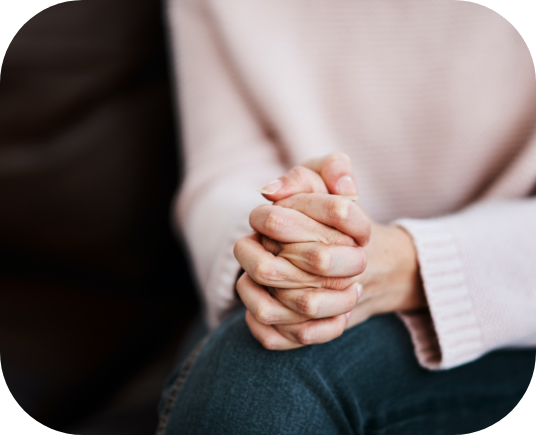

Self-Harm
Self-harm is any intentional injury to one’s own body. The intention is to alter mood. It is not self-harm if the person is doing it for body decoration or to fit in. While body decoration and trying to fit in is intentional, it is not to alter mood state.
Myths About Self-Harm
FACT – People who self-harm are not necessarily suicidal.
Self-harm does not equal suicide. Self-harm is a negative coping skill which people utilize to deal with the circumstances in their life. If the person goes untreated, self-harm could turn into suicide which is why it is important to connect them with help.
FACT – Self-harm is not just cutting.
The most common types of self-harm are cutting (75%), self-hitting (30%), and burning (28%). Females are more likely to practice cutting whereas males are more likely to utilize self-hitting or burning.
FACT – Self-harm impacts all genders.
There are some people who feel self-harm is a “teenage girl” issue. Females are more likely to engage in self-harm as compared to males, but males account for at least 35% of cases. There is also a chance men underreport their experiences with self-harm. People who are 2SLGBTQ+ are at a higher risk of self-harm.
FACT – Adolescents are the more likely age group to harm themselves.
Small children and adults are the least likely to intentionally harm themselves. Teenagers and college students harm themselves at a higher rate as compared to other age groups with 17% and 15% engaging in self-harm, respectively.
FACT – People who harm themselves usually do so in secret.
There is a common misconception people harm themselves for attention, but that is typically not the case. There is a lot of shame and stigma associated with self-harm so people typically hide the fact they are coping with self-harm. Society has perpetuated the silence around self-injury. This silence/stigma makes it very difficult to reach out and ask for help for fear of judgement. In the rare case of someone self-injuring for attention, the person needs help in learning how to get attention from people in a positive and productive way.
FACT – People do not just grow out of self-harm. They need professional help.
There is not a magical turning point where people wake up with healthy coping skills. They take time to develop and practice. The reasons for self-harm are often very complex and a professional can help them deal with all of the facets of what they are going/have gone through.
FACT – This is simply untrue.
People who self-injure feel pain just like anyone else. Oftentimes, people self-injure because they are trying to match their inside, emotional pain with outside, physical pain.
FACT – Self-harm is not for one group of people.
If someone likes the shade black, that does not mean they are not doing well. They could simply like the aesthetic. There is no evidence of self-harm being part of one specific subculture. There is not just one group of people.
FACT – People harm themselves for a variety of reasons.
There are many reasons why someone may harm themselves. Every person’s experience is different. The reason for self-harm is generally rooted in emotional pain, but the cause of this pain is not the same for everyone.

Causes of Self-Harm
There are two overarching reasons why people harm themselves: hyper-stress and dissociation.
Hyper-stress is essentially what it sounds like. Hyper-stress occurs when the person is laden with a lot of stressors in their life. Some stress can be positive, productive, and motivating, but when it becomes too much it becomes toxic stress.
Dissociation is a break in how the brain processes emotions, events, and experiences. It is typically caused from trauma often during childhood. It results in not feeling present in one’s own body. For some, it is almost like watching a play or dolls instead of being present in the moment. In relation to the traumatic incident or their life, the person may have lapses in memory. The person may feel unreal, disconnected, or not present. To cope with feeling unreal, the person may harm themselves.
With both hyper-stress and dissociation, something happens. A trigger. A tipping point. This does not have to be something big. From the outside, it could seem insignificant, but to them, it is a problem. This trigger pushes them to their limit and may cause them to harm themselves to try to match the internal pain/struggle with the outside, physical pain.
Have you ever stubbed your toe and there were a few moments before the pain came rushing in? That is because your body releases neurotransmitters, namely endorphins. Endorphins are released when the body is injured or under stress. They help to reduce feelings of pain. When someone intentionally harms themselves, their body releases a rush of endorphins. The person might feel relief or present within their body.
Harming themselves does not change the stressors in their life. It does not deal with the trauma. The person still has all the same circumstances in their life. It is only a matter of time before the person will feel overwhelmed and laden with stress and emotions. This might cause them to harm themselves again, but it will not feel the same as the first time. Think of the first time you have done anything. The rush was new and exhilarating. It is the same with self-harm. The thing is we can never experience something for the first time again, so the person might try to recapture the feeling by harming themselves more frequently or more severely to get the rush of the endorphins.

What Are The Signs of Self-Harm In Others?
There are a couple of signs to look out for when someone is engaging in self-harm. This is not a conclusive list.
Some signs could include:
- Wearing pants or long sleeves even in warm weather to cover any injury to the body
- Avoiding wearing things like bathing suits
- Having unnecessary sharp objects or tools
- Withdrawing/isolating self
- Feeling helpless, worthless, or hopeless
- Unexplained injuries or the explanations do not quite line up
- Scars in a pattern
- Fresh wounds
- Wearing bracelets, scarves, or other accessories to cover the injuries
What to Do if You Are Self-Injuring?
Remember, there is no shame with self-harm. You were doing what you could to deal with the difficult circumstance in your life, but you deserve to be well. You deserve to feel happy and confident.
First, identify you are not doing well. It is not an easy thing to admit. Just remember, we cannot be tip-top all the time. It is okay not to be okay. It is about seeking help.
Second, talk to someone. Seek help from someone you trust whether a loved one, doctor or mental health professional. You deserve to feel better. It is important to take care of yourself and feel better.
If you are harming yourself, telling someone about it can be difficult, but it is important. Take a moment to think about someone you trust. If you feel like you cannot talk to someone you know, that is okay. There are helplines and health care professionals who are there to listen. When you decide to tell someone, do what works best for you. For some people, it might be writing it down and for others, it might be saying it out loud. If you tell someone and they do not listen or react poorly, remember this is not a reflection on you. It is a reflection of them and their own biases or issues. Tell someone else. You deserve to get help! No matter who the person is, it is important you also connect with professional help. It is their job to help you.
Third, practice self-care. Make healthy choices to support your mental health. Take some time for yourself to feel better, to unwind, and to take care of yourself.
In addition to seeking professional help, there are some things you can do to support your mental health. Click on the Tips for Wellness below or the Wellness Sessions.

How to Help?
There is great stigma surrounding self-harm. This stigma makes it difficult to reach out for help due to fear of judgement. Because of this stigma, when someone tells you they are harming themselves, it can be hard to know what to say. That is a terrifying thing. It is easy to become caught up in emotions. Many people fear saying the wrong thing. We often want to try to fix our loved one’s problem or counsel them, but that is not your job. Your main job is to tell someone and connect your friend to help.
When a child/youth/teen tells you they are struggling, it can be terrifying, and it can be hard to know what to do/say. It is easy to become caught up in emotions. Many people fear saying the wrong thing. We often want to try to fix the youth’s problem or counsel them, but that is not your job. Your main job is to connect the person to help.
The following are some guidelines of what to do when the youth tells you they are struggling and how to handle those difficult conversations. This is not to counsel the person. This is to get the person connected with a helping professional. Please remember the conversation will not be linear like on the page. These are guidelines of some things to consider.
The youth is telling you something scary and personal to them. This is terrifying for both of you. Take a moment to gather yourself and take a deep breath. Remember this is about them and their experience. When we care about someone and they tell us about their struggles, we sometimes react with what seems like anger. This is often an outward display of fear which comes across as anger. This can make it difficult for the person to open up to you.
Take a moment to recognize your own biases or judgements about mental health issues. You are entitled to your opinion, but remember this conversation is about the youth. It is about their emotions, experiences, and perception. It is all valid and real for them. If you are going to have the conversation, place your judgements or preconceived notions aside to allow for understanding and compassion.
Validate, Encourage, Empower, Refer. (This is not counselling the person. It is connecting them with help).
Having someone disclose mental health issues can be very challenging. Because it is scary, we sometimes want to ignore it, but you have a duty to report to connect the youth to help.
Talking to a youth who is struggling is challenging. Talk to someone about it to help cope with the stress of the situation. Practice self-care. Do something you enjoy. For self-care ideas, visit the self-care section here.
Sometimes, people are not ready to talk to you. That is okay. It is their choice. Simply let them know you are there to talk if they need someone and give them resources.
Remember VEER.
Validate, Encourage, Empower, Refer. (This is not counselling the person. It is connecting them with help).
Validate – Validating is so important. It is letting the person know what they are feeling is okay. It is acknowledging their emotions as understandable.
For example:
- Yeah, that would be frustrating.
- I am sorry that happened to you.
- It is understandable you feel that way. I would feel that way, too.
- I believe you.
- From what you are saying, I am hearing you are…because of… Is that correct?
Encourage – This is letting the person know they did a good thing by telling you. Talking about mental health struggles can be very challenging. Let them know they are doing the right thing by telling you.
For example:
- Thank you for telling me. That must have been challenging.
- You did the right thing by telling me.
- I am here for you.
Empower – Struggling with mental health issues can be overwhelming, so it is important to let the person know there is help and they can feel better.
For example:
- I know things seem really overwhelming, but there are resources and people to help.
- Let’s find some things which can help you feel better.
- You deserve to feel happy! We will find a way to get there.
Refer – Connect the person with help. They deserve to feel happy and healthy again. There are resources to help them. The youth needs to get help. You are obligated to connect the youth with professional help. Refer the youth to professional help like a school counsellor, family liaison worker, or an elder. You can also offer them some helplines they can call when they are struggling, too.
For example:
- Here are some phone numbers you can call when you feel like you need someone to talk to.
- Let’s look up some resources and see what you like best.
- There are many options of people you can talk to. We could talk to the doctor, find a counsellor, or elder. What would you be most comfortable with?
Give the person the time and consideration you would like if you were struggling. Be the person you would like in the situation. Give them your full attention. They deserve it. Listening will also help you know what the person is trying to tell you. While you are listening, be understanding and compassionate. Give them the
How to Talk to Someone About Their Mental Health?
If you have a feeling something is going on, have a conversation with the person if you feel comfortable talking to them. (If you do not feel comfortable, that is okay. You just need to tell someone who will have the conversation with them and connect them with help).
The following are some guidelines of what to do if you suspect someone is suicidal or not doing well. This is not to counsel the person. This is to get the person connected with a counsellor, doctor, or another professional. Please remember the conversation will not be linear like on the page. These are guidelines of some things to consider.
Before You Have the Conversation:
- Make sure you have time for it
- You are in a place the person will feel comfortable talking to you
- Approach the situation with compassion
- Make sure you are willing to listen
- Remember you can initiate the conversation and let them know you are there, but it may take some time before they talk to you.
- Take notice. If you feel like something is going on with someone, there likely is something. Trust that gut instinct.
- Talk to them. Open the conversation in a nonjudgemental and compassionate way. Begin the conversation by stating a change you have noticed. Use “I” statements so it does not feel like you are accusing them.
- Example: “Hey, I have noticed you have been cancelling plans lately. How are you doing?” or “I heard you putting yourself down in class. What’s been going on?”
- Remember VEER – Validate, Encourage, Empower, Refer. (This is not counselling the person. It is connecting them with help).
- Do not ignore it. Having someone disclose mental health issues can be very challenging. Because it is scary, we sometimes want to ignore it, but you have a duty to report to connect the youth to help.
- Get help for you, too. Talking to a youth who is struggling is challenging. Talk to someone about it to help cope with the stress of the situation. Practice self-care. Do something you enjoy. For self-care ideas, visit the self-care section here.
- Sometimes, people are not ready to talk to you. That is okay. It is their choice. Simply let them know you are there to talk if they need someone and give them resources.
Follow-up Support for Someone Coping With Self-Harm
Teachers
- Create a safe environment for students
- Connect a struggling student with help
- Integrate mental health awareness into your practice
- Learn about self-injury and the signs
Things to Avoid
- Telling the person to stop immediately – While this may seem like a good idea, it can send the person into crisis. Self-injury is their way of dealing with the problems in their life. If that is taken away, they might feel like they have no way of dealing with the stressors in their life. This is why it is so important to connect them with professional help, so they can learn positive coping skills to replace their negative coping skills.
- Making it about you – When someone you love is struggling, you might internalize the problem and blame yourself. This is common. This is about them not you. Treat the person with kindness, compassion, and support. If you are struggling, talk to a professional.
- Threatening the person
- Keep it a secret
- Ignore the situation or avoid talking about it – Avoiding the topic of self-harm does not make it go away. It perpetuates the stigma and does not change the reality of some people using it to cope.
- Minimizing the person’s experience
Tips for Wellness
Breaking the habit of self-harm can be a difficult process. With professional help, there are a couple of things a person can do to support their wellness and break the cycle of self-harm.

Healthy Coping Skills:
- Make a list of reasons to stop self-harming and read it when there is a temptation of self-harm
- Think about current stressors and scribble on a piece of paper
- Scream into a pillow
- Journal (destroy the paper after if worried about having it written down)
- Watch a funny movie
- Call a friend, family member, hotline, or counselor
- Listen to music
- Do something fun
- Go for a walk outside
Further Resources
The Cornell Research Program on Self-Injury and Recovery
Self-injury/cutting – Symptoms and causes – Mayo Clinic
Myths and Misconceptions of Self-Injury: Part II | Psychology Today
Self-harm and Suicide – Centre for Suicide Prevention (suicideinfo.ca)
Self-Harm Statistics and Facts | The Recovery Village
Self-harm | NAMI: National Alliance on Mental Illness
Precursors to self-injury – LifeSIGNS
If you would like to speak to someone about mental health issues, the Alberta Health Services Mental Health Help Line is available 24/7, offering information and referrals on any aspect of mental health.
Call toll-free: 1-877-303-2642
Trending Topics
Depression
Depression What Is It? Depression is a mood disorder which means it impacts how a person is feeling. It can cause a person to feel
Accidental Overdose
Accidental Overdose What Is it? An overdose is what happens to someone’s body when they take too much of a substance or too many substances.
Online Relationships
Online Relationships Online can be fun! There are games, music, and videos. We can talk to friends and family online. Tips for Being Safe Online:
Online Relationships
Online Relationships Online can be fun! There are games, music, and videos. We can talk to friends and family online. Tips for Being Safe Online:

